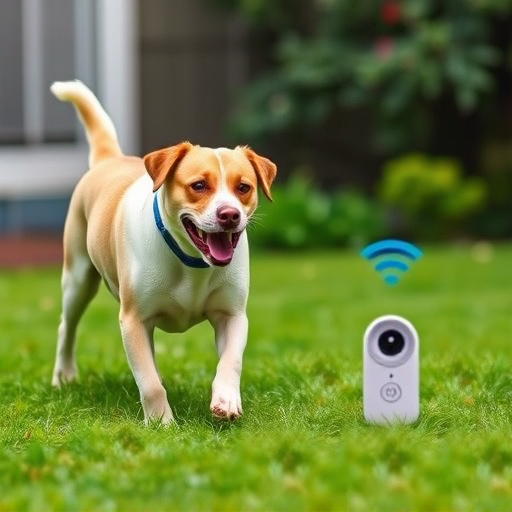Ultrasonic dog repellers, favored by pet owners for their humane training capabilities, emit inaudible high-frequency sound waves to deter dogs without causing harm. With battery lives ranging from 150 to 800 hours, depending on quality and usage settings, these devices offer continuous protection indoors and outdoors. Regular maintenance, including battery checks and adjustments, ensures optimal performance while safety precautions, guided by manufacturer recommendations, are crucial for responsible use in shared environments.
“Uncover the secrets of an innovative pet training tool—the Sonic Animal Training Safety Device, also known as ultrasonic dog repellers. This article delves into the technology behind these devices, their effectiveness in deterring unwanted behaviors, and the practical aspects of battery life. We explore whether these repellers are a safe and reliable solution for both pets and owners, providing insights to help you make an informed decision. Additionally, we shed light on common questions regarding their performance and maintenance, focusing on crucial factors like ultrasonic dog repeller battery life.”
- Understanding Ultrasonic Dog Repellers: How They Work
- Benefits and Efficacy: Do They Really Work?
- Battery Life: What to Expect and How to Optimize It
- Safety Considerations: Are These Devices Safe for Pets and People?
Understanding Ultrasonic Dog Repellers: How They Work
Ultrasonic dog repellers are innovative devices designed to keep dogs away from specific areas without harming them. These tools emit high-frequency sound waves that are unpleasant to dogs but often inaudible to humans. The device operates on a simple principle: dogs, startled by the ultrasonic sound, will avoid the treated area. This technology is particularly useful for keeping dogs off furniture, garden plants, or even certain pathways.
The battery life of an ultrasonic dog repeller varies across models but is generally sufficient for continuous use over several days or weeks, depending on the device’s settings and the size of the area it covers. Users can typically expect a battery charge to last anywhere from 150 to 300 hours before needing replacement, making them convenient for both indoor and outdoor applications. Regular battery checks ensure the repeller remains active, effectively deterring canine intruders.
Benefits and Efficacy: Do They Really Work?
Many pet owners are turning to Sonic Animal Training Safety Devices, especially those that utilize ultrasonic technology, as a humane and effective way to train their pets. These devices emit high-frequency sound waves that are harmless to animals but can capture their attention and deter unwanted behaviors. One of the key benefits is their ability to reduce or eliminate barking, howling, or other vocalizations without causing harm, making them ideal for managing noisy pet dogs.
The ultrasonic dog repeller’s battery life is a significant advantage. These devices are designed with long-lasting batteries that can operate for extended periods on a single charge, ensuring consistent performance over time. This feature is particularly useful for outdoor settings or areas where constant monitoring is required. Several studies and user reviews suggest that these devices are effective in modifying pet behavior, providing a safe and reliable alternative to traditional, potentially harmful methods.
Battery Life: What to Expect and How to Optimize It
The battery life of an ultrasonic dog repeller is a key factor for pet owners considering this training tool. These devices typically run on either replaceable batteries or rechargeable lithium-ion batteries. In terms of expectancy, high-quality models can last anywhere from 300 to 800 hours or more on a single set of batteries, depending on usage frequency and settings.
To optimize battery life, users should adjust the device’s sensitivity and range settings according to their needs. Lowering the sensitivity reduces power consumption while maintaining effectiveness. Regular cleaning and maintenance also help prolong battery life. Additionally, purchasing high-capacity or extended-life batteries can further increase the device’s operational duration between charges.
Safety Considerations: Are These Devices Safe for Pets and People?
Safety considerations are paramount when introducing any device aimed at modifying animal behavior, especially around pets and children. Ultrasonic dog repellers, despite their non-toxic and humane nature, operate on high-frequency sound waves that might not be noticeable to humans but can startle or deter dogs. However, these devices have been extensively tested for safety, with no significant adverse effects reported in numerous studies.
The key to ensuring safety lies in responsible use. Owners should follow manufacturer guidelines regarding battery life and usage duration to avoid prolonged exposure to the ultrasonic signals. Moreover, placing such devices out of reach of curious pets or children can prevent any potential mishandling. Regular monitoring is crucial, especially when introducing new gadgets into an environment where both humans and animals coexist.
Ultrasonic dog repellers have gained popularity as a humane way to deter unwanted behavior, but understanding their safety and effectiveness is crucial. By examining how these devices use sound waves, their benefits in training, and the key factors affecting battery life, pet owners can make informed decisions. While generally safe for both pets and humans when used correctly, ongoing research continues to explore their long-term effects. Optimizing battery life through regular charging and efficient usage ensures these repellers remain a reliable tool for positive reinforcement training.
